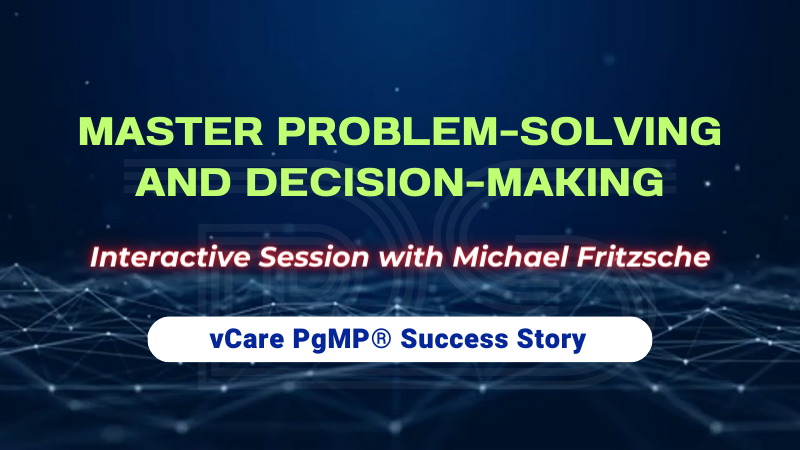
by admin | Mar 9, 2024 | Professional Development Webinars
Join me for an exclusive webinar where Michael Fritzsche, a distinguished Project, Program, and Portfolio Management professional in the automation industry from Rheinböllen, Rhineland-Palatinate, Germany, will share his journey and experiences, offering attendees a unique perspective on overcoming challenges and leading strategic projects.
Key topics to be covered include:
– Equipping Senior Managers for Strategic Decision-Making.
– The Dynamics of Human Judgment vs. Algorithms in Decision-Making.
– Best Practices for Building Stakeholder Trust and Credibility.
– Effective Use of Deadlines to Boost Productivity.
🔗 Reserve your spot now: https://bit.ly/3ON2Ibl
Session Date: 21st March 2024
Session Time: 09:30 AM – 10:30 AM (PDT) / 10:30 AM – 11:30 AM (MDT) / 11:30 – 12:30 PM (CDT) / 12:30 PM – 01:30 PM (EDT) / 01:30 PM – 02:30 PM (BRT) / 04:30 PM – 05:30 PM (GMT) / 05:30 PM – 06:30 PM (CET) / 07:30 PM – 08:30 PM (AST) / 08:30 PM – 09:30 PM (GST) / 10:00 PM – 11:30 PM (IST)
🚀 Elevate Your Project Management Career:
– Book an obligation-free consultation session on Project management Career, training, and certifications: http://talktodharam.com
– Discover training offers and certification discounts: https://bit.ly/3jWVepD
– Stay updated with our Q&A series and certification success stories by subscribing to the vCare Project Management YouTube channel at https://bit.ly/2YF0wJl
– Follow my podcasts and interviews with Project Management Experts on YouTube at https://bit.ly/2NDY8wd
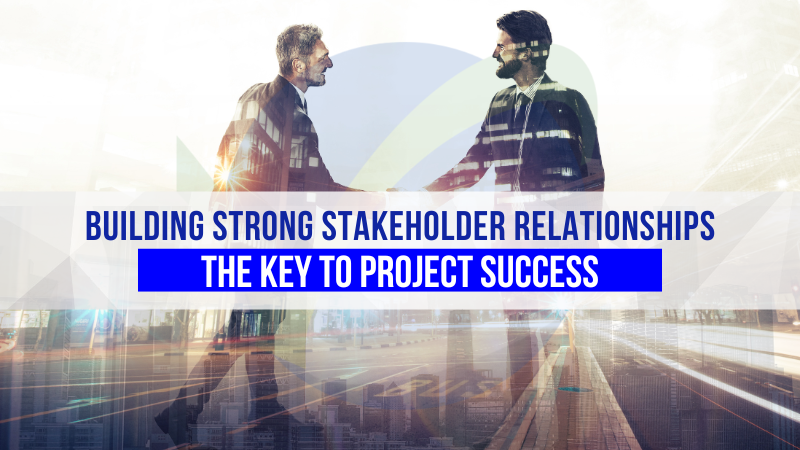
by DharamCW | Feb 7, 2024 | Leadership in Project Management
Maximizing Success – Benefits of Building Stakeholder Relationships
In the realm of project, program, and portfolio management, forging robust stakeholder relationships is a cornerstone of success. I want to highlight why nurturing these connections is pivotal for organizational growth and individual career trajectories.
A strong stakeholder rapport yields:
– Enhanced trust and reciprocal confidence
– A harmonious work environment with less stress
– Sharpened problem-solving acumen
– Informed and agile decision-making processes
– Elevated bid values and client/employee retention rates
– Ample personal growth, paving the way for career advancement
– A resilient foundation for navigating complex challenges
– An enduring legacy that underpins future projects
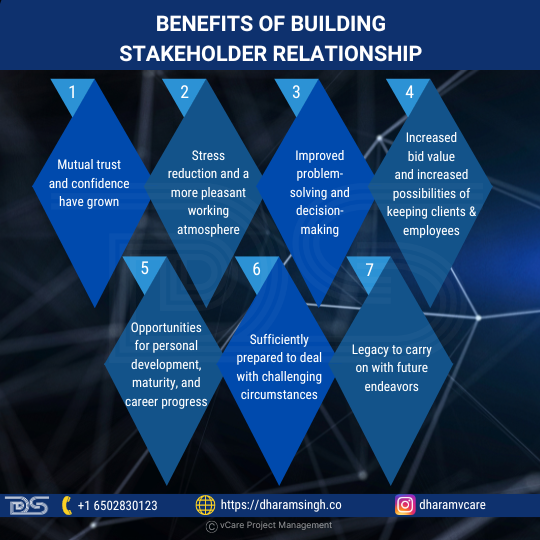
Benefits of Building Stakeholder Relationships
Investing in stakeholder relationships is more than a strategy; it’s a commitment to cultivating a thriving ecosystem that benefits all parties involved.
Let’s embrace the journey of building stakeholder relationships that stand the test of time and change.
🚀 Elevate Your Project Management Career:
– Register for my upcoming PgMP/PfMP Success Story Webinar: https://bit.ly/3S53K3a
– Book an obligation-free consultation session on Project management Career, training, and certifications: http://bit.ly/2SbhTOK
– Discover training offers and certification discounts: https://bit.ly/3jWVepD
– Stay updated with our Q&A series and certification success stories by subscribing to the vCare Project Management YouTube channel at https://bit.ly/2YF0wJl
– Follow my podcasts and interviews with Project Management Experts on YouTube at https://bit.ly/2NDY8wd
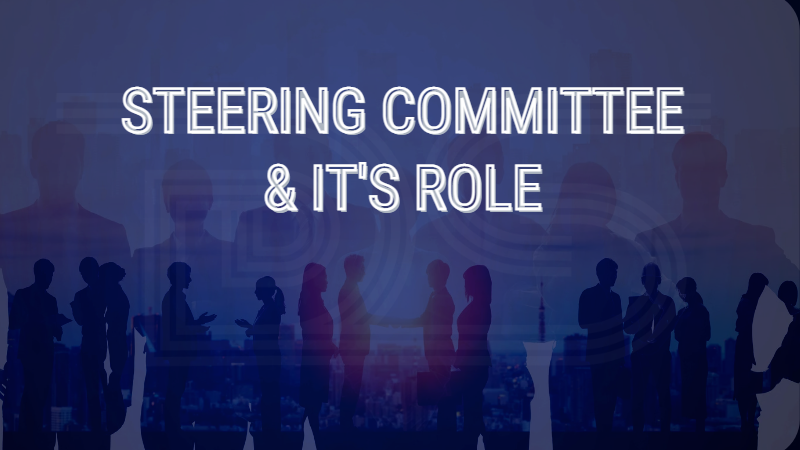
by admin | Jun 4, 2023 | General
Project management may be challenging. Addressing changing business demands, allocating limited resources, and managing team workloads can all result in dealing with complicated project management aspects on a day-to-day basis. However, having high-level assistance and guidance can be a lifesaver. Steering committees accomplish precisely that. Project management steering committees give administrative assistance and troubleshoot issues to keep projects on schedule to achieve their objectives.

Steering Committee
Steering Committee
A steering committee is an advisory body of important stakeholders overseeing and supporting a project to ensure its success. Project steering committees are also known as stakeholder boards, senior leadership teams, and project working groups. They manage projects from beginning to end, offering direction and assistance throughout the project’s lifecycle.
A steering committee’s primary concern is the organization’s direction, scope, budget, timeline, and techniques. Steering committees will meet regularly to discuss these issues to identify where they are and where they want to go to stay on track.

Project Steering Committee
Project Steering Committee
A steering committee may also be a group working together on initiatives. In this case, steering committees assist project managers in ensuring that projects are aligned with business objectives. They identify and manage risks, maintain project quality, and track progress and timeframes. In addition, the committee can approve changes to the project scope, budget, and strategy.
A project steering committee is a part of a larger organization for project governance. Companies that plan major projects that need collaboration across departments and include multiple stakeholders gain from a steering committee that can direct project management. The committee supervises the team’s progress toward fulfilling benchmarks and goals in this role.
The committee is in charge of project management, financial analysis, and recognizing changes that influence the project’s original scope. Furthermore, the project steering committee ensures that all points of view are heard and that any problems between stakeholders or departments are resolved.
Role of a Steering Committee
A steering committee can accomplish its core goal by utilizing a range of group and individual functions. When a steering committee gives advice and guarantees that items are delivered on time and in good condition, a company may reap significant benefits from its project successes. Some of the most important group-based steering committee positions that influence a business’s and consumers’ satisfaction with a product include:
- Providing input on the growth or development of a business or initiative.
- Addressing concerns and offering guidance on budgeting, marketing, recruiting, and other financial issues.
- Identifying the outcomes or objectives that the project must achieve.
- Prioritize the steps and objectives that must be completed to meet the project’s objectives.
- Assisting in the formulation of business-related policies, processes, and guidelines.
- Identifying, monitoring, and eliminating potential operational risks.
- Setting project deadlines or timelines and keeping track of progress.
- Monitoring the final work’s quality.
- Making plans for how a client or consumer will react to a product or service.
- Analyzing and discussing changes that have occurred or will occur to guarantee the project’s success.
- In the workplace, encouraging team members to collaborate.
- Where relevant, providing further insights on business or project concerns.
Members of the steering committee generally do not work on the project directly; nevertheless, committee members may perform various tasks individually to help assure the project’s success. Therefore, individual steering committee members should understand and strive to improve the strategies used to achieve project goals, be genuinely interested in the project and its outcome, promote the project whenever possible, and maintain a broad understanding of project management concerns, in addition to attending team meetings.

Key Functions of The Steering Committee
A steering committee is an advisory committee made up of various stakeholders and firm officials. They assist in making choices on various initiatives, with members directly interacting with project managers. Here are some of the key functions of the Steering Committee:
- Advocacy
A steering committee advocates for the organization’s varied goals and programs. Remember that it is generally composed of top management and specialists.
- Setting strategies and goals.
Steering committees develop strategic directions for initiatives. They also provide advice and opinions on budgeting, assets, money, time, facilities, marketing, and hiring. Goals and project scope are established as part of their employment.
- Coming up with ways of measuring success
There are several metrics for measuring performance. The steering committee is in charge of establishing how a product’s success is measured.
- Monitoring
The steering committee serves as an advisory body as well as a monitoring body. It ensures that projects fulfill the necessary quality standards and monitors any changes. It also keeps track of project processes and plans, which is critical to project success. The committee also analyzes and monitors project or company hazards before devising solutions to mitigate them.
- Offering expert opinion
The steering committee comprises experts who provide expert opinions on various issues concerning projects or the entire business. Their involvement is generally required, especially while working on a complex project.
- Conflict resolution
Disagreements are normal, mainly while working on a specific project. However, to ensure that issues do not disrupt the overall project, these committees resolve disputes between stakeholders, giving them more time to focus on what is best.
- Problem-solving
One of the functions of any advisory body is to discover solutions to problems the organization may be experiencing. It can generate various problem-solving ideas due to the experts on the strategy committee.
- Decision making
Although the steering committee’s primary function is to provide counsel, it also participates in decision-making. For example, it can analyze, accept, or reject project plans or recommend revisions to the supplied plans based on the members’ feedback.
The committee also engages in role allocation because its members can appoint project managers and other professionals to complete assigned tasks.
Ways to prepare for the project steering committee meeting
Important information and documents must be communicated with all steering committee members before the planned meeting, including:
- Meeting agenda
- Minutes of the previous steering committee meeting
- Project progress report from the project manager
Certain team members should be in charge of creating steering committee meeting documents and scheduling meetings. The steering committee is led by a chairperson who runs the meeting according to the agenda. They also ensure that all committee members express their viewpoints and ideas.
A basic meeting agenda would include the following:
- Recognizing and distributing the previous steering committee meeting minutes with other committee members.
- Conduct a thorough review of action items decided at previous sessions.
- Analyze the project status report filed by the project manager.
- Have a thorough discussion about any additional issues of concern or project requests.
- Select a date, time, and location for the next steering committee meeting.

Steering committee Best Practices For Project Success
Steering committee best practices for project success
Consider the following steering committee best practices for project success, whether you hold your meeting online or in person:
- Allow adequate time for the project team and committee members to prepare.
- Focus on the most important project KPIs and milestones and deliver them to the committee members in a format that everyone can agree on, such as a presentation, report, or infographic.
- Present project facts that are factual, contextual, and relevant. Share any inconsistencies or difficulties as soon as possible before they become significant issues.
- Schedule meetings in advance and automate meeting alerts to go out a week and a day ahead.
- Ensure comprehensive documentation of all meeting discussions and distribute it to committee members before the next meeting.
- Maintain the project charter and refer to it whenever there is doubt about authority, accountability, or strategic direction.

Challenges for Steering Committees
Challenges for Steering Committees
Because project management steering committees are comprised of employees from various backgrounds and functions, they will almost always experience certain challenges. These are some examples:
- Conflicting interests:As the committee includes cross-functional representatives, they will frequently have opposing ideas and interests. People think differently, which may be shown in their behavior, activities, and perspectives.
- Slow decision-making:Team decision-making is typically slower than individual decision-making.
- Lack of clarity in roles:Many committee members may need to know their individual or team responsibilities. A clearly defined charter for the steering committee ensures transparency and clarity about their duties in the project.
Final Thoughts
Every organization needs a Project Steering Committee to lead its transformation initiatives, beginning with a contemporary approach to project management. It may be instantly productive by initiating the process of managing project priorities. Steering committees are extremely crucial in efficient project management. They add value by keeping projects on pace, reducing risks, and resolving problems. When creating one, it is essential to evaluate the overall composition.
The steering committee plays a crucial role in project management that should be considered. The steering committee is the project’s administrator. This functionality does not exonerate the project of responsibility. On the contrary, this role necessitates that the steering committee participates in the project and not simply monitors the project group’s performance from the sidelines. This move will strain the steering committee’s multiple tasks and the time spent on the project.
Feel free to check out my discussion on this topic with Justin Buckwalter in YouTube
For any questions related to your Project Management career, training, and certifications, you can book an obligation free 15 minutes session with me by visiting talktodharam.com
You can subscribe to the vCare Project Management YouTube Channel to catch future videos of our Q&A series and certification success stories: https://bit.ly/2YF0wJl
You can subscribe to and follow my podcasts and interviews with Project Management Experts on YouTube at https://bit.ly/2NDY8wd
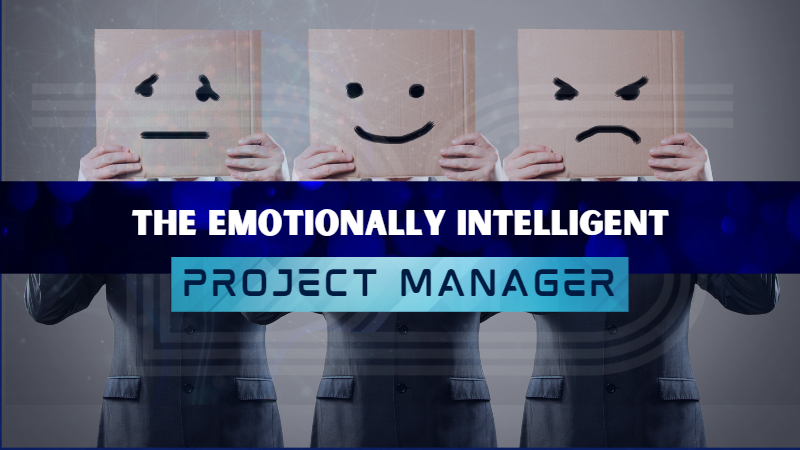
by admin | May 19, 2023 | General
Emotional intelligence in the workplace is becoming increasingly important for leaders and project managers as remote work became more prevalent due to the pandemic. Success in project management and managing cross-functional remote teams is only possible with emotional intelligence.
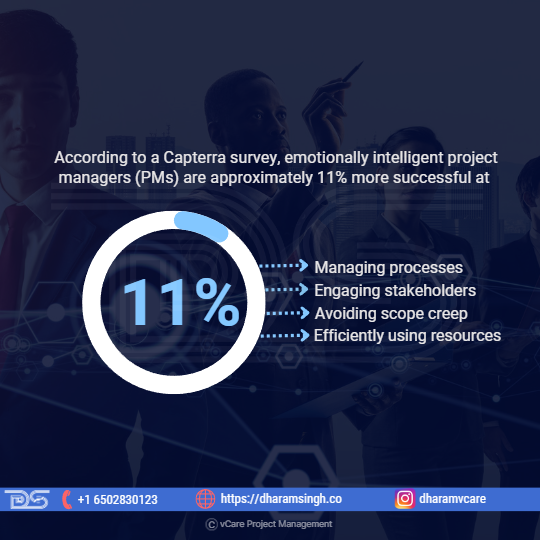
Capterra Survey
According to a Capterra survey, emotionally intelligent project managers (PMs) are approximately 11% more successful at managing processes, engaging stakeholders, avoiding scope creep, and efficiently using resources than PMs who lack this skill.
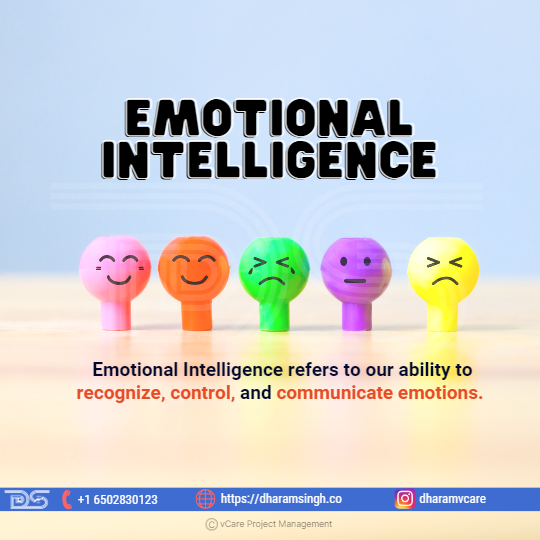
Emotional Intelligence
What is Emotional Intelligence?
Emotional intelligence refers to our ability to recognize, control, and communicate emotions. People with high emotional intelligence understand how they feel, what their feelings imply, and how their feelings affect others. In interpersonal situations, it is also the ability to empathize with others. Emotional intelligence is about creating a positive work environment, which is critical to the success of any project.
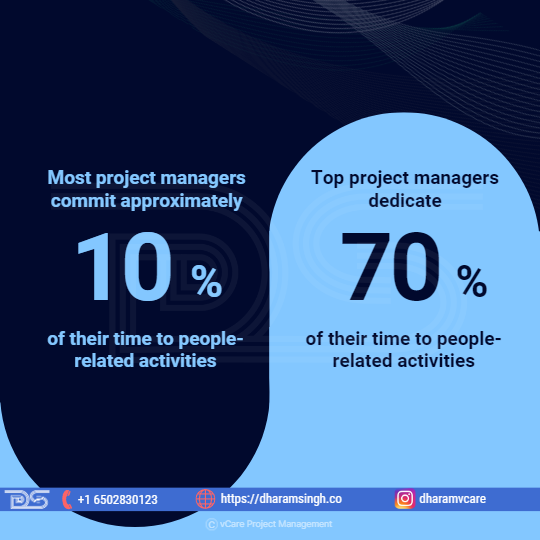
As Per LiquidPlanner Study
According to a LiquidPlanner study, most project managers commit approximately 10% of their time to people-related activities. Top project managers dedicate 70% of their time to these activities. As a result, we can conclude that emotional intelligence is crucial for project success.
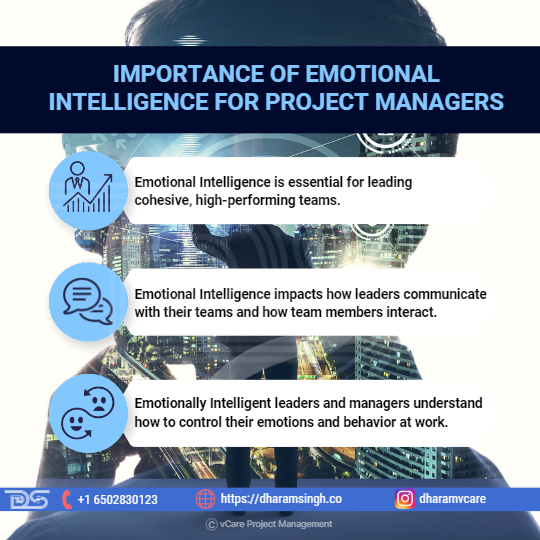
Importance of Emotional Intelligence for Project Managers
Importance of Emotional Intelligence for Project Managers
- Emotional intelligence is essential for leading cohesive, high-performing teams.
- According to researchers and behavioral scientists, Emotional intelligence impacts how leaders communicate with their teams and how team members interact.
- Emotionally intelligent leaders and managers understand how to control their emotions and behavior at work, which includes providing safe environments for exchanging ideas and feedback, productive teamwork and performance, good morale, employee engagement, and job satisfaction. They manage workplace stress and conflict with care and educate their team members to do the same.
Characteristics of Emotional Intelligence
What can project managers do to help themselves develop and become more aware? First, let’s examine five abilities for raising emotional intelligence:
- Self-Awareness – The ability to sense, identify, and comprehend emotions is self-awareness. Unfortunately, many of us were taught to ignore our emotions in the past. However, it is critical to be aware of your feelings to make appropriate decisions and act accordingly. Those with high self-awareness are self-assured, authentic, open to feedback, and capable of maintaining perspective throughout all project phases.
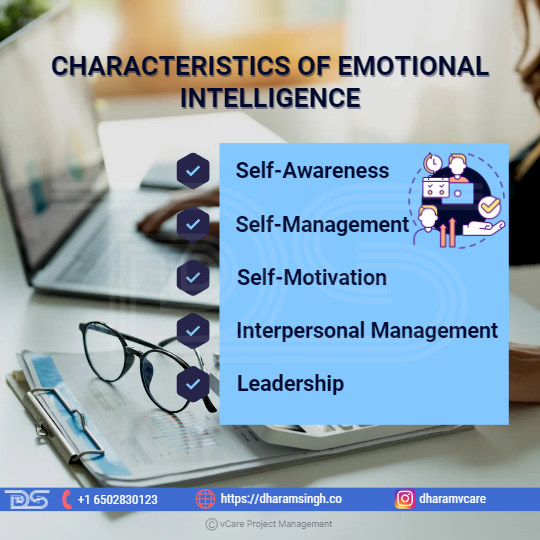
Characteristics of Emotional Intelligence
- Self-Management – Self-management is the ability to reason well while understanding feelings. Many frequently react based on their frame of reference rather than selecting a response based on their current unique circumstances. Self-managers are deliberate in decision-making, taking the initiative, framing events appropriately, maintaining perspective, and responding quickly. They understand their feelings and why they have them and effectively manage their responses.
- Self-Motivation – Self-motivation is the ability to channel the power of your emotions toward a specific goal. When project teams have a purpose, these ‘P’s follow peace, passion, power, perspective, and potential leverage. Self-motivators who are influential are optimistic and have a positive attitude. They can delay gratification and assert themselves.
- Interpersonal Management – The capability to identify and respond properly to the emotions of others is referred to as interpersonal management. If you can connect with people and acknowledge their humanity, they will answer openly, leading to common trust.
- Leadership – An emotionally intelligent project manager inspires guides, challenges, and supports the team. Leadership is defined as the ability to create and communicate vision and passion for assisting individuals and organizations in reaching their full potential.
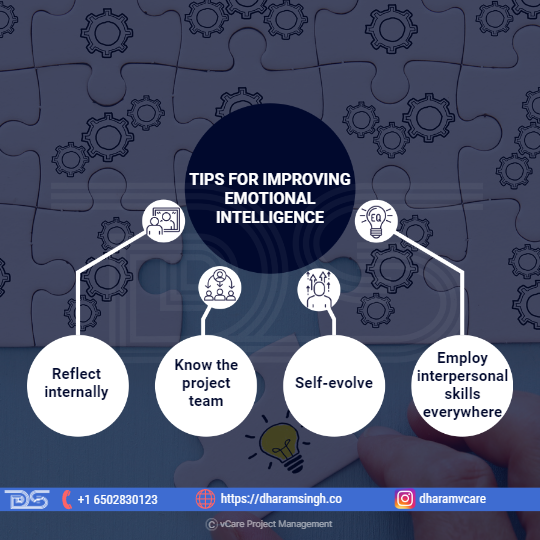
Tips for improving Emotional Intelligence
Tips for improving Emotional Intelligence
- Reflect internally – To become more emotionally aware, one must first understand their emotions and then regulate them in stressful situations. Next, they have to figure out what motivates them. Finally, authenticity is necessary to develop emotional intelligence by leading a successful project team and establishing meaningful relationships with stakeholders.
- Know the project team – Project managers are usually aware of the people they must contact when working on a project. However, understanding the project team, from team dynamics to personalities to dealing with conflict and stress, is just as important. To improve emotional intelligence, one must first get to know their team, communicate with them, and understand their emotions. It will also help the success of their project. This job becomes even more important for teams that operate in multiple locations and are diverse.
- Self-evolve – Along with other important leadership talents, project managers should work to improve their emotional intelligence regularly. Conditions surrounding a project frequently change; its scope may shift, the number of stakeholders may increase, and projects may eventually end.Every project is distinct, and no project manager can complete a project independently. Therefore, it is advantageous for project managers to consider what they learn during and after a project. For example, consider how a project team operated, what they witnessed during critical times with stakeholders, and their team’s performance.
- Employ interpersonal skills everywhere – Emotional intelligence can be helpful in almost any project management situation. For example, people may feel compelled to sign off on a strategy to minimize delays while managing scope changes or project risk. Following the resolution of such issues, an emotionally intelligent project manager would pursue people because they notice that this could lead to more severe problems in the future.
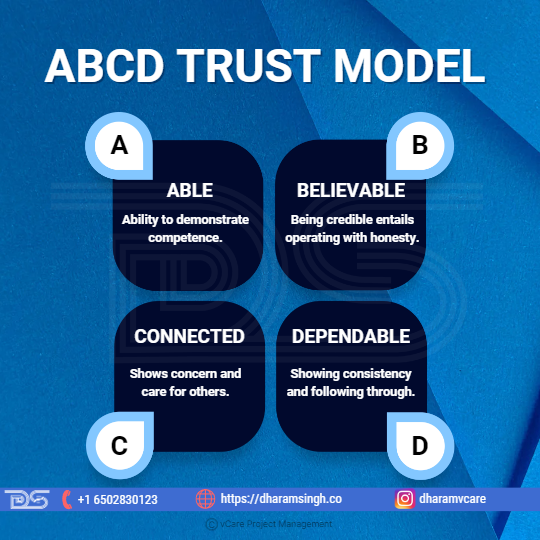
ABCD Trust model
ABCD Trust model
Better relationships will result in better outcomes. That is why developing trusted connections is critical to the success of your organization. When individuals trust one another, they may work efficiently together.
It is well known that low trust harms morale, productivity, and turnover. To prevent these traps, Ken Blanchard created the ABCD Trust Model to help executives understand the activities that affect creating trustworthy relationships.
Blanchard suggests four critical aspects for leaders to develop trust with people: Able, Believable, Connected, and Dependable.
- Able – The term able refers to the ability to demonstrate competence. Leaders demonstrate competence by possessing the necessary skills, education, credentials, and experience. They also exhibit their capacity to lead by accomplishing achievements. Able leaders can encourage people and collaborate with them to achieve goals.
- Believable – Being credible entails operating with honesty. Believable leaders adhere to a set of core beliefs. They know what they stand for and will not compromise their principles under pressure. Being credible also means maintaining promises and not lying or stretching the truth.
- Connected – Connected shows concern and care for others. This aspect fosters trust and contributes to a more engaged workplace atmosphere. Being linked entails attending to people’s needs and promoting their well-being. Leaders also build relationships by giving information not only about the organization but also about themselves. Employees are significantly more likely to provide their best effort when they feel linked to leaders.
- Dependable – Dependable means showing consistency and following through. It entails holding oneself and others accountable for commitments. A trustworthy leader will accept responsibility for their acts and help their followers face adversity.
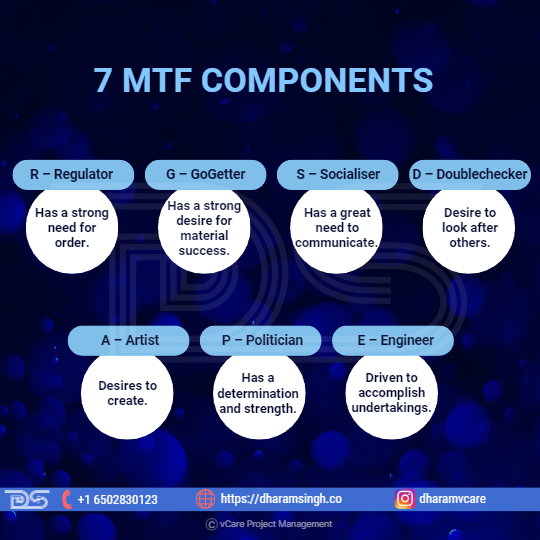
7MTF Components
7MTF Components
The 7MTF model is composed of seven components. We all have all 7 in our personalities; as adults, 2 to 4 will be strong, some will be weak, and others will be ordinary. This mix of elements is one of the most significant variables in deciding our temperament – our emotional predisposition.
- The R – Regulator (formerly known as the Normal) – A person with a ‘strong R’ has a strong need for Order. They will be mature, responsible, calm, and emotionless. You may hear the words ‘should,’ ‘ought,’ and ‘logical’ in their language. They have high expectations of themselves and others, including those with whom they live and work.
- The G – GoGetter (formerly known as the Hustler) – A person with a ‘strong G’ has a strong desire for material success. This individual entails enjoying money and the things it can purchase. The G is quick, opportunistic, intelligent, enterprising, and charming. They are short-term in nature, expecting results immediately or very soon. Promising a G a large monetary reward next year is unlikely to pique their attention.
- The S – Socialiser (formerly known as the Mover) – The ‘strong S’ personality has a great need to communicate. This aspect implies talking about people, fun, events, what you did over the weekend, or anything related to life. Hence, their straightforward, friendly, and frequent grin immediately.
- The D – Doublechecker – The ‘strong D’ is characterized by a desire to look after others and ensure everyone is safe. When you encounter a strong D, expect someone obedient, loyal, and concerned with doing the right thing. One of their greatest assets is their ability to anticipate difficulties and hazards.
- The A – Artist – A person with a ‘strong A’ desires to create. “I want to be different,” is what they would say. These hardworking individuals are conscientious and do not wish to offend anyone. Seek for anything unusual about their attire, such as innovative earrings, cufflinks, a six-button jacket, or an all-black ensemble!
- The P – Politician – A solid handshake and direct eye contact indicate that the ‘strong P’ is determined to win. This person has a determination and strength that others may find challenging. The spoken word is the strong P’s stock in trade – look for status markers like the huge Mercedes in metallic blue.
- The E – Engineer – A person with a ‘strong E’ personality is driven to accomplish undertakings. The strong E has traits such as process, detail, and procedure. This individual can form a strategy and make it happen as soon as they see anything. The E is concerned with completion. So, unless you can assist, you should avoid getting in the way!
Wisdom – strive for mental stability and individual resilience – 10 Competencies
Wikipedia defines wisdom as the “ability to contemplate and act using knowledge, experience, understanding, common sense, and insight.” Psychologists have created a list of ten competencies that are typical therapies in their field and are referred to as wisdom. Self-awareness, self-control, and empathy are the three components of emotional intelligence (EI). Although the fourth component of EI is not formally mentioned among the ten competencies, social influence or influencing others may be considered a result of being highly effective in the other areas.
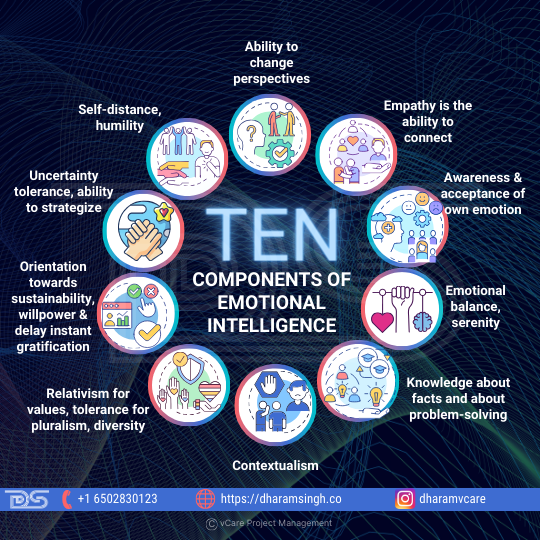
Ten Components of Emotional Intelligence
- Ability to change perspectives – In a bipolar environment, it is possible to remain trapped in one thought and dislike the other viewpoint with strong emotions, which may lead to violence. The ability to look for and identify more points of view implies a shift in viewpoint. Some of the therapies used to treat mental illnesses can help with this. Examples include role-playing, acting, visiting people in various countries, learning about diverse cultures, and brainstorming.
- Empathy is the ability to connect – Understanding people’s intentions, current state of mind, emotions, and mindsets is necessary for being heard, establishing trust, and influencing others. In addition, active listening techniques may help you focus outside yourself and view others as humans who vary from ourselves.
- Awareness & acceptance of own emotions (self-awareness) – Self-awareness leads to increased self-confidence and sincerity. It refers to mindfulness, or being aware of one’s feelings, and is required for self-control and emotional balance.
- Emotional balance, serenity (self-control) – Patience, serenity, and avoiding knee-jerk reactions make you more popular and respected and contribute to mental tranquility. Having a mentor can help you develop and fine-tune this skill.
- Knowledge about facts (know what, assimilation) and about problem-solving (know-how, accommodation) – Wisdom includes knowledge; therefore, it has two components.
- On the one hand, we have factual knowledge about a topic; on the other, we may be specialists in a (typically technical) area. This heuristic knowledge and assimilation are how we apply established systems to circumstances.
- On the other hand, when we encounter new situations or topics, we use accommodation to apply our problem-solving skills. We employ our epistemic intelligence and heuristics to do this.
- Contextualism (consider the situation, timeline, and social relevance) – Even though we have theories and may find similarities in new scenarios, each situation is unique and depends on the circumstances, the context in which the problem develops, and the societal importance. This capacity is achieved via awareness and avoiding picking a solution that works in another context without first examining the present dependencies of the situation.
- Relativism for values, tolerance for pluralism, diversity (which is hard if you are part of the same belief systems for most of your life, like nations and churches) – There are many truths (this is known as non-monism), and yours is only one of them. Others have the right to their realities, which are based on the cultures in which they live, their beliefs and experiences, and the facts to which they have access. Value relativism allows one to accept and appreciate the values of others.
- Orientation towards sustainability, willpower, and delay instant gratification (perspective of linear and circular time flow) – We can pursue long-term goals and make decisions with both short and long-term consequences in mind.
- Uncertainty tolerance, ability to strategize (imaging solutions for scenarios) – Accept that life is unpredictable and swim through it like a river, adapting to currents and waves as they come.
- Self-distance, humility – Do not believe you are the center of the universe, which will remain when you die. Avoid being a taker rather than a giver by avoiding jealousy, bragging, pride, and greed.
Final Thoughts
For today’s project managers, emotional intelligence is a critical concept. Many companies are looking for project managers with strong technical and soft skills. Emotional intelligence is crucial in project management because it enables project managers to improve communication and collaboration in the workplace. It is essential to mention that emotional intelligence can be imparted and nurtured. This aspect implies that as a project manager, one can better oneself by controlling feelings and emotions and developing positive behaviors to influence others at work. One will make better decisions about other people’s emotions, strengths, and weaknesses once they have recognized their thoughts.
Feel free to check out my discussion on this topic with Thomas Walenta in YouTube
For any questions related to your Project Management career, training, and certifications, you can book an obligation free 15 minutes session with me by visiting http://talktodharam.com/
You can subscribe to the vCare Project Management YouTube Channel to catch future videos of our Q&A series and certification success stories: https://bit.ly/2YF0wJl
You can subscribe to and follow my podcasts and interviews with Project Management Experts on YouTube at https://bit.ly/2NDY8wd
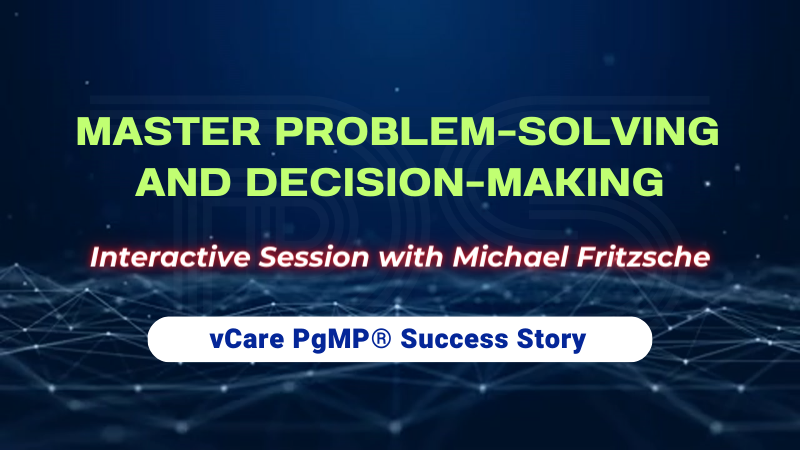
























Recent Comments